How Facing Your Space Could Improve Your Writing
Today’s guest post is by architect Donald M. Rattner.
As an architect who studies the psychology of creative space, and the author of a recently published book on the subject, I’m often asked by my fellow scriveners what the most common mistake writers make in fitting out their physical workspace.
Easy, I reply. They’re looking the wrong way.
Looking the wrong way? It sounds like what happens to a North American who travels to the UK and forgets that the traffic moves in opposite directions when stepping out into the street.
No, what I’m referring to isn’t about failing to adjust for unaccustomed traffic patterns. It has to do with how we humans have been genetically encoded to orient themselves to our environment, and how we remain guided by that code even though the conditions that prompted this bit of bioengineering have long disappeared.
To understand what I’m getting it, we’ll need to travel back in time about 190,000 years, to when the first Homo sapiens emerged on the African savanna.
Jay Appleton and the Theory of Prospect-Refuge
Sitting in biology class, did you ever wonder how it was that of all the various species stemming from the genus homo only we Sapiens managed to survive into the present day?
One contributing factor might be that we knew a good spot to call home when we saw it.
British geographer Jay Appleton was among the first to float the idea in his 1975 book The Experience of Landscape. Based on his study of landscape art, Appleton reasoned that early humans were instinctively driven to establish habitats that afforded maximum prospect, meaning view, while simultaneously providing maximum refuge, or protection, from attack by predators approaching from the sides or above. He termed this instinct the prospect-refuge principle.
Driving the urge was the goal of self-preservation. By positioning themselves in safe redoubts, our ancestors could limit population loss and further their chances of enduring in a hostile environment.
A key aspect of evolution, however, is that it moves very, very, very slowly. So slowly, in fact, that our brains haven’t caught up to the fact that we’re no longer likely to become some wild animal’s lunch, a lag that explains why subconsciously we still feel compelled to seek out strategic vantage points that allow us to survey our domain from a secure position. You can see the lingering effects of this impulse in the photograph at the top of this post; perched high on a steep slope, surrounded by a dense cushion of trees and rock, the hut holds visual and emotional appeal for us in part by promising safety from attack while offering a sweeping 180-degree view of the valley below.
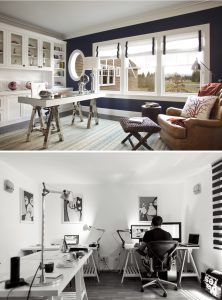
Prospect-Refuge and Interior Space
If prospect-refuge is in fact an intrinsic behavioral impulse, then it stands to reason that it should apply to how we position ourselves inside the built environment, as well as outside. After all, being indoors does not relieve us of the need to protect ourselves from intruders, whether psychologically or in real life.
The owner of the study pictured at the top of the image above understood this imperative, either explicitly or intuitively. Notice how the desk has been placed so that the person sitting at it can scan nearly the entire space, including any points of entry, as well as access vistas to the outside—that’s prospect to the max. Notice, too, how the wall behind the desk offers protection from behind—that’s refuge.
Now compare that space with the one pictured below. Here you see what I mean by “looking the wrong way”—instead of facing into the room, the occupant looks directly at a wall; instead of being protected from behind, his back is fully exposed to that which he cannot see, including the view through a window.
But is ignoring principles of prospect-refuge really so bad for maintaining a healthy mental state, and if so, why is it particularly detrimental to creativity?
Stress: Creativity Killer Number One
We tend to think of stress as a bad thing—and it is, when we continually experience an abundance of it, as happens all too frequently in the hectic world we live in. But in the context of the drive to survive, stress can actually be a life saver because of how it changes the way humans think.
To appreciate this insight, imagine you’re driving down a country road late at night, and suddenly a deer leaps out in front of you. How do you react? For starters, your brain begins furiously pumping the stress hormone cortisol into your system in response to what you see. That’s very much to your benefit, because cortisol raises alertness, focuses attention, leads you to avoid risk, and energizes memory—exactly the kinds of mental states that will help you escape your predicament.
On the other hand, such a mind-set is exactly what you don’t want to be in when you’re engaged in a creative task. Creative thinking is by its nature the antithesis of the kind of analytical, rational sort of mental processing that you utilize to calculate an effective solution to your deer problem.
Instead of focused attention you want your mind to wander; instead of alertness you want to be relaxed and even dreamy; instead of avoiding risk you want to embrace it; instead of drawing from memory to come up with that one right answer to your dilemma, you want to entertain lots of possible answers for the more open-ended types of problems that typify creative undertakings.
Fair enough, but what do stress and creativity have to do with prospect-refuge theory? Plenty, because Nature has programmed us to experience stress whenever we fail to achieve sufficient prospect and refuge in positioning ourselves in space—it’s her way of signaling to us that we have potentially placed ourselves in harm’s way, and therefore have threatened our own survival. As far as creativity is concerned, the end result is the same — a disinclination to indulge in de-focused attention until the demands of prospect-refuge are satisfied.
How to Accommodate Prospect-Refuge
Here are some guidelines to consider when planning a space attuned to the principles of prospect-refuge.
Find your edge. Situate yourself along the edge of your space and orient your furnishings so that you look into the room and have a wall or solid element behind you.
Avoid backing up against a wall that affords passage into the room, however; this conflicts with the psychological need for feeling protected from sudden encroachment. Ideally, interior openings will be opposite or perpendicular from your principal workstation.
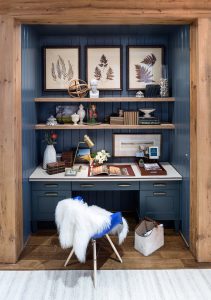
Compensate where necessary. Situations inevitably arise where you’re compelled to face a wall or expose your back to a surrounding space. This commonly occurs where desks are placed in blind alcoves, a space is too small or narrow to have freestanding furniture or equipment, or a view is so alluring that it seems criminal not to plunk yourself right smack in front of a window.
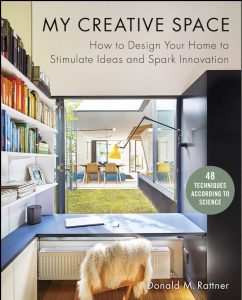 You can take steps to mitigate the downsides. For workspaces set into an alcove, consider adorning the back wall with artwork, wall coverings, recessive paint colors, and materials that prime concepts of distance or nature to ameliorate the shallowness of the space (see the image above). Another option is to hang a mirror that will give you a view back into the room, and allow you to spot people coming into the space. A mirror could work equally well for desks and upright pianos butted up against a wall.
You can take steps to mitigate the downsides. For workspaces set into an alcove, consider adorning the back wall with artwork, wall coverings, recessive paint colors, and materials that prime concepts of distance or nature to ameliorate the shallowness of the space (see the image above). Another option is to hang a mirror that will give you a view back into the room, and allow you to spot people coming into the space. A mirror could work equally well for desks and upright pianos butted up against a wall.
What to do when you have a view. Should you succumb to the lure of a gorgeous vista, you can still assume a defensive position by placing a piece of furniture behind you to serve as a psychological barrier against your rear flank. Besides subtly improving peace of mind, the piece could also add welcome functionality and, for extra measure, fill an awkward void in the furniture plan.
Another option: rotate your work surface so that it’s perpendicular to the window. You’ll maintain your access to the view, enjoy the light, and be a tad less tempted to gorge yourself on what lies outside when you should be working.
 Architect Donald M. Rattner helps individuals and organizations maximize their creativity by drawing on scientific research into the psychology of space. Educator and author as well as practitioner, Rattner’s publications include the award-winning My Creative Space: How to Design Your Home to Stimulate Ideas and Spark Innovation, entries in professional reference books, and numerous contributions to print and online channels.
Architect Donald M. Rattner helps individuals and organizations maximize their creativity by drawing on scientific research into the psychology of space. Educator and author as well as practitioner, Rattner’s publications include the award-winning My Creative Space: How to Design Your Home to Stimulate Ideas and Spark Innovation, entries in professional reference books, and numerous contributions to print and online channels.
This article was adapted from My Creative Space. All photographs are courtesy of the designer or photographer.
Featured photo: Pawleys Island, South Carolina. Building design by Wall Building & Design. Interior design by Lance Griffith for CHD Interiors. Photography by Matt Silk.

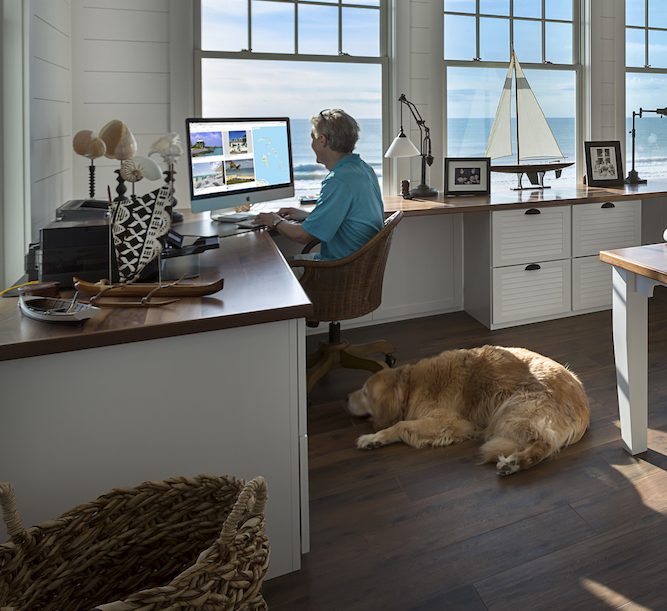



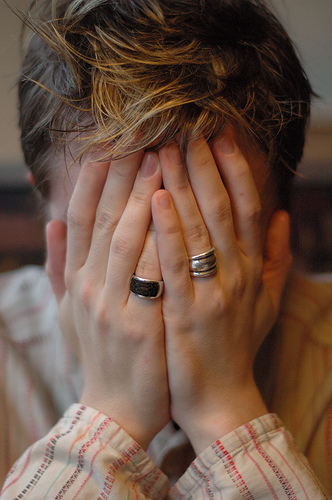
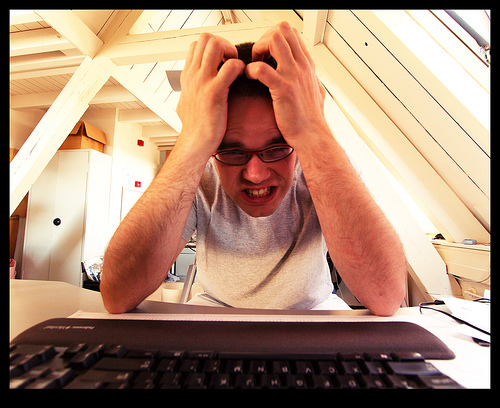
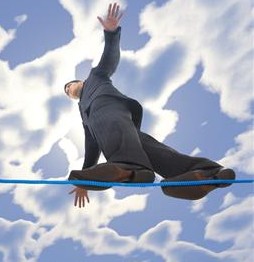




I have actually done this on pure instinct. Additionally, I have my desk angled in a triangle with the corner of my room, so I can access book shelves on either side and escape both ways! ha ha. It also makes room for a small filing cabinet behind my sitting place, and gives me room to move on my ball (I sit on a pilates ball). And makes me closer to the fan in the middle of the room while keeping the internal lines of the space flowing, as there are two single beds to the left of me and my husband’s desk in front and perpendicular. The entrance is between us. I have definitely been more productive since rearranging my desk to be here.
Katinka, you might already be aware of this, but placing your desk at an angle to the corner of a room is a common technique in the practice of feng shui, which similarly advocates for consistently ‘facing one’s space’, or as they commonly term it, ‘taking a commanding position’ in a room. It’s one of several areas where modern science and the age-old practice overlap.
Interesting. I can see how this might apply. My dad, who has been a police officer for most of his adult life, likes to sit in a back corner when in a public place so he can get a full view of the space around him. But could this tendency to be vigilant of your surroundings (even subconsciously) generate a form of stress? Couldn’t something be said for finding safety in a small comfortable space? Humans, after all, have sought refuge in small places for safety since their dawning, whether it be in caves or homes with small (if any) windows. I, for one, don’t think I could be comfortable sitting in front of a big window as pictured above. It might be pretty, but I don’t like the idea that someone from the outside can look in. I also think it might be distracting.
Dawn, your Dad’s approach to placing himself in a space is very indicative of people in the security field. They typically look for a vantage point that affords them a balance between protection and being able to survey the field of activity in front of them. In that sense, the corner of a room is a perfect spot because in achieving that balance they will actually lower their stress levels, whereas satisfying only one or the other condition might raise it. Ditto for writers!
Thanks for sharing this interesting article!